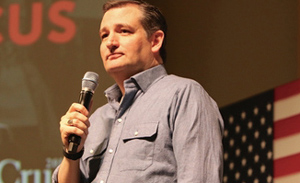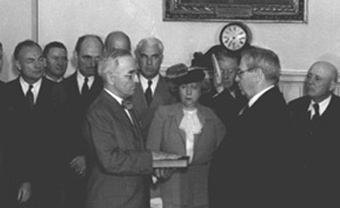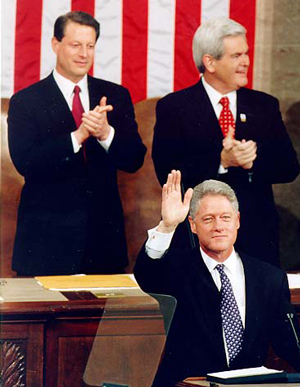Tough choices
During his or her time in office, the next president will have to confront the fiscal issues facing the United States. Given the projections of growing deficits, record levels of debt, unsustainable entitlement programs, and the negative effects all of these have on the economy and families’ well-being, attempting to avoid dealing with our fiscal challenges would be extremely detrimental. While addressing the debt will be difficult, succeeding in implementing sensible reforms will provide immense upside for the economy and nation.
To increase the likelihood of success, the future president will have to start laying the foundation now, during the campaign. Easier policy priorities such as tax cuts or new investments (particularly ones that aren’t paid for) can be introduced into the political discussion at pretty much anytime during a president’s term. But those that entail tough choices—and fiscal reforms rank at the top of that list—need to be discussed during the election in order to create a mandate, or at least a better understanding, of what will be involved.
This will entail regularly raising the issue of the national debt on the campaign trail, as well as discussing specific examples of policies candidates would support, to prepare voters for the kinds of choices that will be needed. Once in office it will require the new president to both make the issue a priority and reach out to members of the opposing party—not just symbolically, but earnestly with a willingness to compromise on a budget deal, since it is highly unlikely either party will confront these issues on their own.
Campaigning responsibly on fiscal issues is challenging. Candidates prefer to focus on their more enticing promises—promises of new initiatives to meet important national priorities from education to infrastructure to caring for families, as well as tax cuts. And this does not merely break down on party lines as one might assume. Democrats typically offer a multitude of tax cuts as part of their campaign agenda, while Republicans have many priorities that expand spending or benefits through the tax code.

But none of the important campaign priorities—from growing the economy and increasing our national competitiveness to boosting families’ financial security and creating more opportunity—can be achieved without a strong fiscal underpinning to the economy.
Despite the headline good news about how much the deficit has come down since it peaked during the financial crisis, fiscal conditions remain quite precarious. The national debt is over $13 trillion, or 74 percent of GDP—the highest it’s been other than around World War II. Under current projections, close to $7 trillion will be added to the debt in the next eight years. Interest costs will more than triple and will be the fastest growing part of the federal budget. Meanwhile, the Social Security trust funds will run out of money in the early to mid-2030s, and the Medicare trust fund is slated to run out even sooner. Without action, the exhaustion of these trust funds will lead to large across-the-board cuts, including for the most vulnerable populations. Continuing to delay these reforms, as we have done for many years now, will only make them more difficult and painful.
On the campaign trail there is a lack of realistic discussion about what fixing the debt would entail.
Unfortunately, on the campaign trail there is a lack of realistic discussion about what fixing the debt would entail. Realistic campaign promises would not include massive unpaid-for tax cuts or huge spending programs that consume the offsets needed to close the fiscal gap, but that is exactly what has dominated the presidential primaries. To balance the budget by the end of the next president’s second term—an aggressive goal that has been articulated by some—would require saving roughly $5 trillion over the eight years. Even much less restrictive fiscal goals, such as bringing the debt down closer to historical levels as a share of the economy, will require changes throughout the budget. This includes significant savings from the largest areas, which are Social Security, Medicare, and defense; a real willingness to end outdated programs throughout the budget; and a higher level of revenues. No candidate should take any options off of the table with pledges or promises—and most certainly not until they have provided a detailed plan for how they would close the gap.

The first critical step for the new president will be submitting his or her first budget in early February 2017. A president’s budget is the single most important comprehensive policy statement he or she makes. It communicates to Congress and the public the administration’s priorities, policies, and plans for financing them, and it’s a chance to show how the president’s most ambitious proposals or promises made on the campaign trail are fiscally workable and feasible, giving them legitimacy. A president’s first budget proposal is especially important, as it outlines a governing vision for an entire presidency.
Harry Truman was perhaps the first president to realize the importance and influence of the budget. “It is clear that the budgetary program and the general program of the government are actually inseparable,” Truman said. “The president bears the responsibility for recommending to the Congress a comprehensive set of proposals on all government activities and their financing.” Truman even combined his State of the Union and proposed budget into a single message to Congress, and, for the first time, included estimates not only for policies enacted by Congress, but also for those he recommended.
Ever since, presidents have seized this opportunity and included many of the policies that eventually came to define their legacy in their first budget. President Reagan’s first budget included dramatic reductions in taxes, cuts to non-defense spending, and defense spending increases that defined his legacy. President George W. Bush’s first budget included proposals for major tax cuts, increased federal support for education, and a Medicare prescription drug benefit, while President Barack Obama outlined his proposals for health care reform, tax credits for low-income families, and extending most of the Bush tax cuts. While many of these policies were not immediately put into law the year they were first proposed, including them in the president’s first budget helped place them on the legislative agenda and showed the new president was committed to enacting them.

President Bill Clinton’s experience provides an instructive example of the importance of addressing the country’s fiscal imbalances early on. While on the campaign trail, Clinton promised to increase public investments and cut taxes for the middle class while also cutting the deficit in half by the end of his first term. Shortly after he took office, however, both the Congressional Budget Office and the Office of Management and Budget revised their estimates and projected a much gloomier budget outlook. Realizing the seriousness of the country’s fiscal problem, Clinton chose to prioritize deficit reduction over cutting taxes. His first budget set out as a top priority a “balanced deficit-reduction plan to stop the government from draining the private investments that generate jobs and increase incomes,” saving $477 billion over five years and including unpopular proposals for an energy tax and higher taxes on Social Security benefits. In doing so, Clinton established that dealing with the nation’s fiscal challenges would be one of his top priorities, which helped kick off a successful fiscal legacy for his administration.
An appropriate goal, given economic and fiscal conditions and political realities, would be for the next president’s first budget to include a credible plan to achieve declining debt as a percentage of the economy for every year in office and beyond. This metric could be used for the congressional budgets and any other budget deal as well. This would reassure markets, lead to a significant improvement in the long-term debt, decrease the chance of any fiscal crisis, allow more flexibility in the budget for future crisis, and even leave room for additional priorities—whether spending increases or tax cuts—to be included in the budget as long as their costs were offset.
Any successful attempt to deal with the nation’s fiscal challenges will have to be bipartisan.
There are other measures the president should take beyond the critically important first budget. Any successful attempt to deal with the nation’s fiscal challenges will have to be bipartisan. There have been many recent attempts to implement budget deals that have come close but have failed. Particularly notable were the discussions between President Obama and Speaker John Boehner where the two leaders were very close to an historic deal. There are many reasons for the past failures—the difficulty of the task being no small part of it. But one critical component always boils down to trust between the negotiating parties. One both symbolic and useful step a new president could take would be to appoint an Office of Management and Budget Director from the opposing party. This would send a message about the seriousness of budget discussions and would help build trust between the administration and congressional leadership from the opposing party.
Another step is to call for budget discussions immediately after taking office. No matter whether the updated budget numbers are better or worse than before, it is certain they will not be good enough to determine that the country doesn't need to address these issues. This is not to say there will not be other priorities a new president will want to address. But since resource questions affect all areas of policymaking, these should be included in laying out sustainable and viable budget and policy priorities. In the past, too often, presidents have tried to slip through a signature tax cut or entitlement creation before tackling the budget situation, and it has so poisoned the political waters that it made budget deals impossible. This is no small part of the reason why the budget situation has become as bad as it is today.
There are many models the president could follow, from calling for discussions between leadership from both parties to appointing a commission of sitting members or outside experts. All of these models have been tried before, and unfortunately in this past administration none of them were successful. But there will be many details, from picking an achievable goal to holding discussions and building support with the public about the importance of our fiscal national health that will affect the chances for success.
“The combination of the kind of tax initiatives [Clinton] had, the deficit reduction and spending reduction program, and the fact that we had an overall effort to grow the economy led us from those enormous deficits into surplus…”
Finally, there needs to be a governing set of budget rules that transcend individual administrations and level the playing field to help sort out the various competing priorities that will always exist without defaulting to the lowest common denominator of deficit financing, spending expansion, and tax-cut priorities. Two basic rules that have been very successful in the past have been spending caps and pay-as-you-go rules, where any policy change that would increase the deficit is required to be offset elsewhere. While these are currently in place, it has recently become common practice to ignore them, and the new president should reinforce a commitment to abide by them.
There are other useful rules that could be included, such as a broader use of budget policies that are formulated as automatic stabilizers to contribute to growing the deficit when the economy is weak and shrinking it when it is strong. Other mechanisms could increase our focus on the long-term budget and prohibit some of the gaming that has contributed to our national debt and our unsustainable budgetary promises.
It is unimaginable that we will be able to make progress on bringing our debt to more manageable levels and examining our national budget priorities without strong presidential leadership on this issue. The steps the new president takes throughout the campaign and in the early months of his or her new administration will determine whether we as a nation are successful in getting our fiscal path back on track.
Resources
- "Promises and Price Tags: A Fiscal Guide to the 2016 Election," Maya MacGuineas, Committee for a Responsible Federal Budget (June 2016)